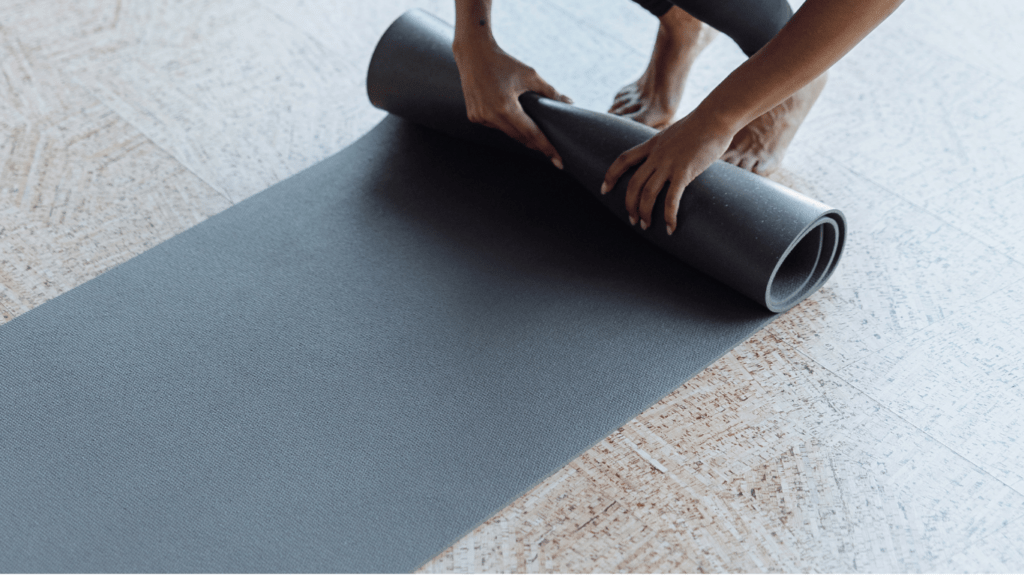Why The Right Yoga Mat Matters
Choosing the right yoga mat is crucial for several reasons.
First, comfort significantly affects one’s practice. A mat with appropriate thickness (e.g., 4-6mm) cushions joints and reduces strain. Second, grip ensures stability during poses. Textured surfaces or mats made from natural rubber prevent slips, especially when sweating. Third, durability impacts long-term use. High-quality materials like PVC or TPE withstand frequent usage.
Comfort
Comfort influences practice effectiveness. Thicker mats offer better cushioning. For example, those practicing Yin Yoga might prefer mats with 6mm thickness for added joint support. On the other hand, a thinner mat (around 4mm) might suit Vinyasa Yoga better for stability and balance.
Grip
Grip maintains pose stability. Mats with textured surfaces or made from natural rubber enhance traction. Brands like Manduka and Liforme provide superior grip, making them ideal choices for hot yoga or intense sessions. A secure grip minimizes injury risks.
Durability
Durability ensures mat longevity. Mats from durable materials like PVC or TPE resist wear. Regular practitioners benefit from investing in high-quality options. Lesser mats deteriorate quickly, leading to frequent replacements.
Hygiene
Hygiene is vital for personal practice. Mats that are easy to clean, like those with closed-cell structures, resist absorbing sweat and bacteria. For instance, JadeYoga mats are designed to be more hygienic by repelling moisture.
Eco-Friendliness
Eco-friendliness appeals to environmentally-conscious yogis. Mats made from sustainable materials like cork or natural rubber reduce environmental impact. Brands such as prAna and Yoloha are known for their eco-friendly products.
Investing in the right yoga mat positively impacts practice, comfort, stability, durability, hygiene, and environmental footprint.
Types Of Yoga Mats

Selecting the right yoga mat involves understanding the variety available. Different types cater to specific needs and preferences.
Material
Yoga mats come in several materials, each with unique properties. PVC mats, for example, offer durability and a sticky surface. TPE mats are eco-friendlier and provide good grip. Natural rubber mats, sourced from trees, are biodegradable and offer excellent traction. Cork mats combine sustainability with antimicrobial properties. Cotton mats add a traditional touch, providing a softer feel ideal for gentle yoga styles.
Thickness
Mat thickness directly impacts comfort and stability. Standard mats measure about 1/8 inch, balancing cushioning with stability. Thicker mats, around 1/4 inch, offer extra cushioning, suitable for restorative yoga or those with joint issues. Travel mats are typically 1/16 inch thick, prioritizing portability over padding. Choose based on your practice type and comfort preference, recognizing that thicker mats might compromise stability in balance poses.
Texture
Texture affects grip and comfort. Smooth mats, such as those made from PVC, offer a sticky feel that enhances grip. Textured mats, including some natural rubber or jute mats, provide increased traction, reducing the risk of slipping. The texture may prevent slipping even when the mat becomes wet from sweat. Experiment with different textures to determine which offers the best combination of grip and comfort for your practice style.
Factors To Consider
Selecting the right yoga mat involves evaluating several key factors. Each aspect contributes to overall performance and satisfaction during practice.
Comfort
Comfort is paramount when choosing a yoga mat. A mat should cushion your joints and provide support during various poses. Thicker mats, around 6-8mm, offer more cushioning, ideal for people with sensitive joints. However, if balance and stability are more important to you, a standard mat around 3-5mm might be better. Look for materials like natural rubber or TPE for a balance of cushioning and firmness.
Durability
Durability ensures long-term use of your yoga mat. Materials like PVC and natural rubber are known for their longevity and resilience. High-quality mats withstand daily wear and tear, retaining their shape and grip. Check user reviews and product specifications to gauge the lifespan of the mat you’re considering.
Portability
Portability is crucial if you travel frequently or attend classes outside your home. Lightweight mats, typically around 1-2 kg, are easier to carry. Travel mats often fold or roll up compactly, making them fit easily in a backpack or carry-on. Consider mats made from TPE or thin PVC for a lightweight yet durable option.
Price
Price ranges vary widely for yoga mats. High-end mats with advanced features can exceed $100, while basic models are available for under $20. Consider your budget and frequency of use when deciding. Investing in a pricier mat often provides better durability and additional comfort. However, affordable mats can also offer excellent value if chosen carefully.
Evaluate these factors to find a yoga mat that enhances your practice. Each consideration impacts comfort, durability, portability, and price.
Eco-Friendly Options
Choosing eco-friendly yoga mats addresses environmental concerns. Materials like natural rubber, cork, cotton, and jute serve as sustainable choices. Natural rubber provides excellent grip and cushion.
It’s biodegradable and harvested from rubber trees. Cork mats, lightweight and antimicrobial, offer durability and stability. Cotton mats feel soft and absorbent, suitable for gentle practices like yin yoga. Jute mats blend strength and eco-friendliness. They deliver stability with a natural feel.
| Material | Benefits | Suitability |
|---|---|---|
| Natural Rubber | Excellent grip, cushion, biodegradable | All types of practices |
| Cork | Lightweight, antimicrobial, durable | Hot yoga, intense sessions |
| Cotton | Soft, absorbent | Gentle practices |
| Jute | Strong, eco-friendly | Regular practices |
When considering eco-friendly options, look for certifications like OEKO-TEX or GOTS, ensuring non-toxic and sustainable production. Prioritizing eco-friendly mats supports a sustainable yoga practice and a healthy planet.
Best Yoga Mat Brands
Manduka
Manduka is renowned for its high-quality yoga mats. These mats offer excellent durability and cushioning, making them ideal for various yoga practices. Made from eco-friendly materials like natural rubber and sustainably harvested tree rubber, Manduka ensures both comfort and sustainability. Yoga practitioners appreciate the Pro line for its density and longevity.
Liforme
Liforme mats stand out for their alignment guides, which aid in maintaining proper posture. These mats use eco-friendly materials and provide a strong grip, even during intense sessions. The brand’s commitment to environmental responsibility and innovative design makes it a popular choice among yogis.
Jade Yoga
Jade Yoga is well-known for its sustainably sourced natural rubber mats. They offer exceptional grip and are perfect for hot yoga and vigorous styles. Jade Yoga plants a tree for every mat sold, reflecting its dedication to environmental causes. Enthusiasts applaud the balance of comfort and stability these mats provide.
Gaiam
Gaiam provides affordable, eco-friendly yoga mats suited for beginners. Using materials like TPE and PVC, Gaiam ensures durability without compromising eco-friendliness. Their wide range of designs and thickness options caters to diverse preferences, making them a versatile choice.
Hugger Mugger
Hugger Mugger offers mats made from natural rubber and PER (Polymer Environmental Resin). These mats are known for their durability and excellent grip. The commitment to using non-toxic materials makes Hugger Mugger ideal for health-conscious practitioners. Users appreciate the balance of firmness and comfort.
Yoga Design Lab
Yoga Design Lab blends aesthetics with functionality. Their mats use biodegradable natural rubber and water-based inks, ensuring they are environmentally friendly. The striking designs and quality construction appeal to those looking to combine visual appeal with practicality.
prAna
prAna focuses on sustainability and ethical production. Their mats are made from non-toxic, eco-friendly materials like natural rubber and PER. The brand’s dedication to sustainability is evident in its use of recycled content and commitment to fair labor practices. Practitioners commend the mats for their texture and durability.
| Brand | Key Features | Material |
|---|---|---|
| Manduka | Durability, cushioning, eco-friendly | Natural rubber, tree rubber |
| Liforme | Alignment guides, strong grip, eco-friendly | Eco-friendly materials |
| Jade Yoga | Exceptional grip, suitable for hot yoga, eco-conscious | Natural rubber |
| Gaiam | Affordable, diverse designs, eco-friendly | TPE, PVC |
| Hugger Mugger | Durability, excellent grip, non-toxic materials | Natural rubber, PER |
| Yoga Design Lab | Biodegradable, aesthetic designs | Natural rubber, water-based inks |
| prAna | Sustainability, ethical production | Natural rubber, PER |
These brands provide a variety of yoga mats catering to different needs and preferences while maintaining a focus on eco-friendliness and quality.
 Albert Newman has been a dedicated contributor to Top Wellness Activity Hub, leveraging his extensive background in digital content creation to enrich the platform with engaging and valuable information. Known for his meticulous research and a knack for simplifying complex wellness topics, Albert focuses on producing content that is both informative and approachable. His articles cover a broad spectrum of wellness subjects, from healthy eating habits to the latest trends in yoga and fitness. Albert's ability to break down intricate health concepts into easily digestible insights has made the platform a trusted source for wellness advice.
Beyond his writing, Albert is also deeply involved in the content strategy and editorial planning of the platform. His collaborative approach ensures that each piece of content aligns with the platform’s mission to empower users on their wellness journey. Albert is always exploring innovative ways to engage readers, whether through interactive guides or personalized wellness tips. His commitment to creating high-quality, reader-centric content plays a significant role in the platform’s ongoing success.
Albert Newman has been a dedicated contributor to Top Wellness Activity Hub, leveraging his extensive background in digital content creation to enrich the platform with engaging and valuable information. Known for his meticulous research and a knack for simplifying complex wellness topics, Albert focuses on producing content that is both informative and approachable. His articles cover a broad spectrum of wellness subjects, from healthy eating habits to the latest trends in yoga and fitness. Albert's ability to break down intricate health concepts into easily digestible insights has made the platform a trusted source for wellness advice.
Beyond his writing, Albert is also deeply involved in the content strategy and editorial planning of the platform. His collaborative approach ensures that each piece of content aligns with the platform’s mission to empower users on their wellness journey. Albert is always exploring innovative ways to engage readers, whether through interactive guides or personalized wellness tips. His commitment to creating high-quality, reader-centric content plays a significant role in the platform’s ongoing success.